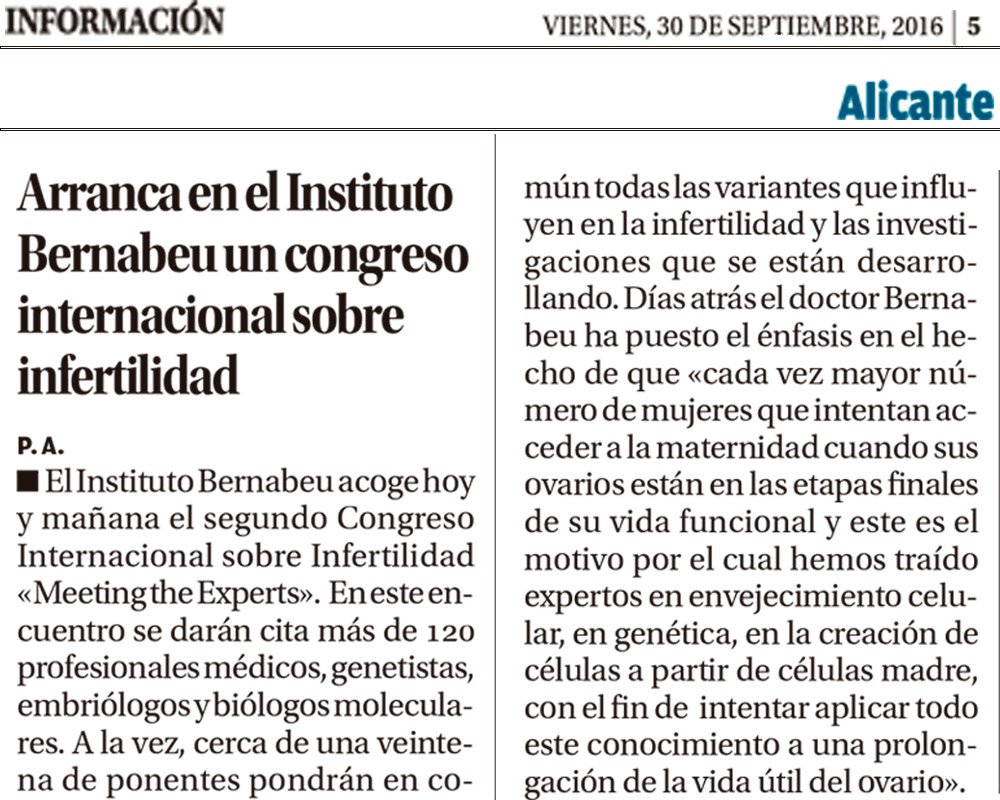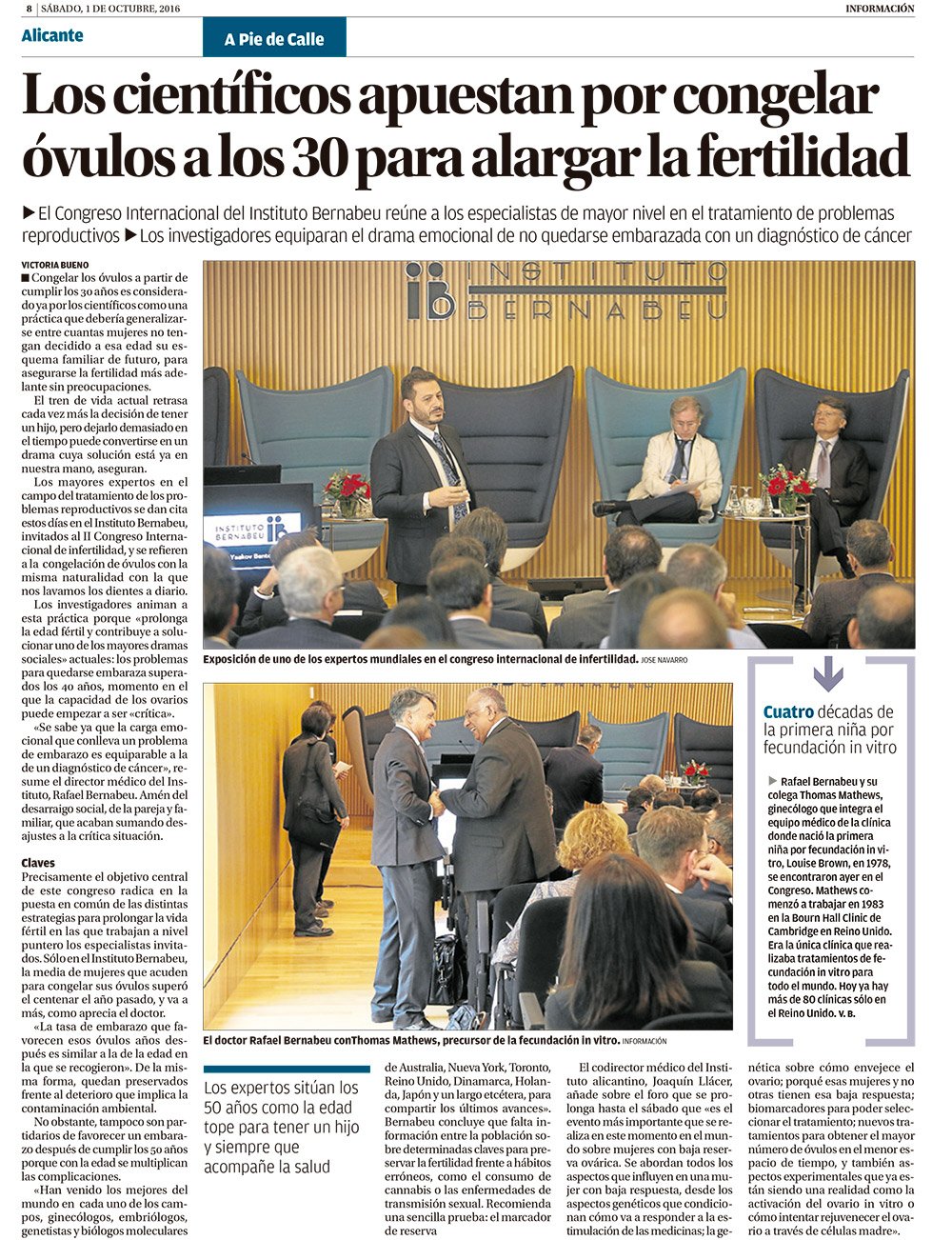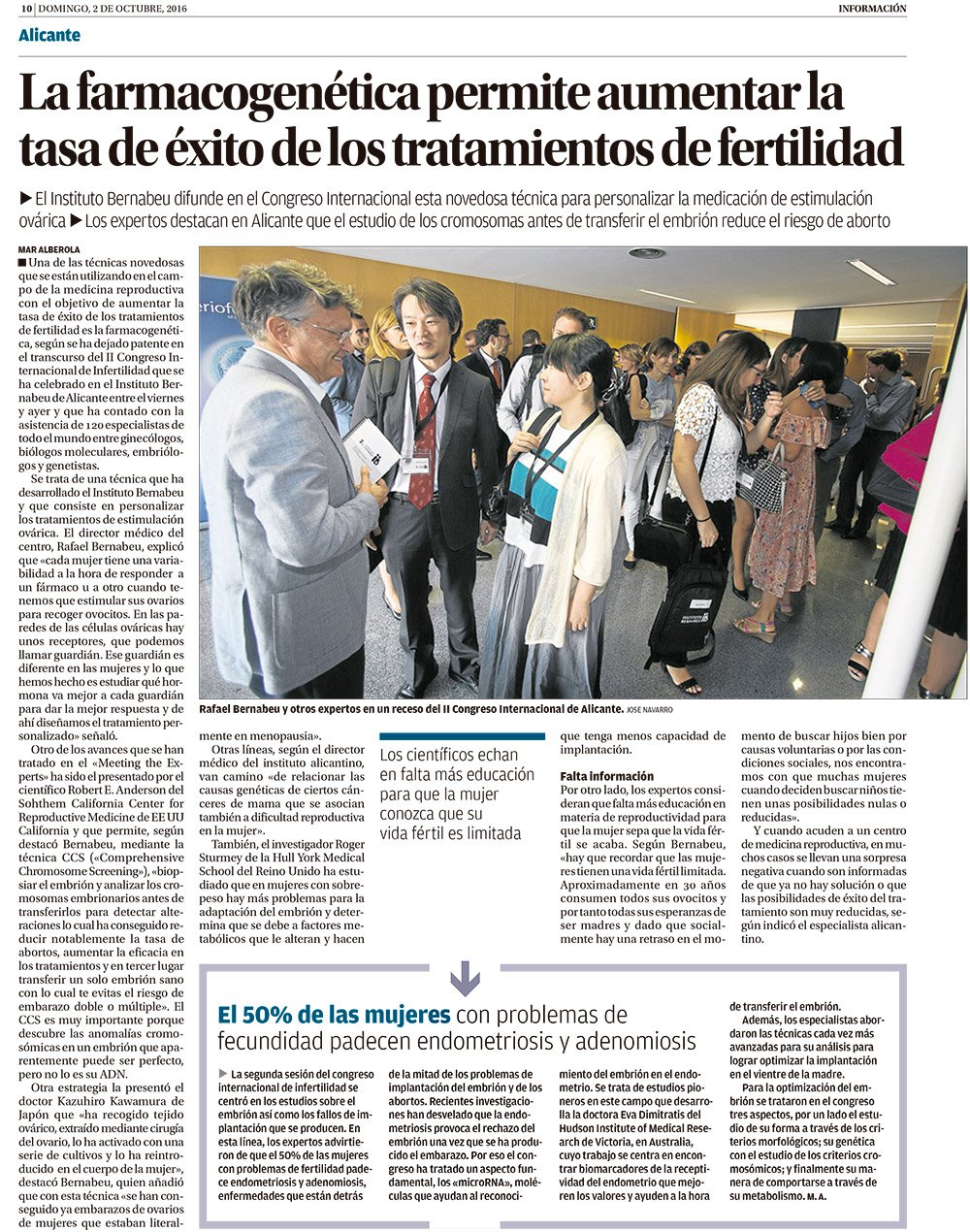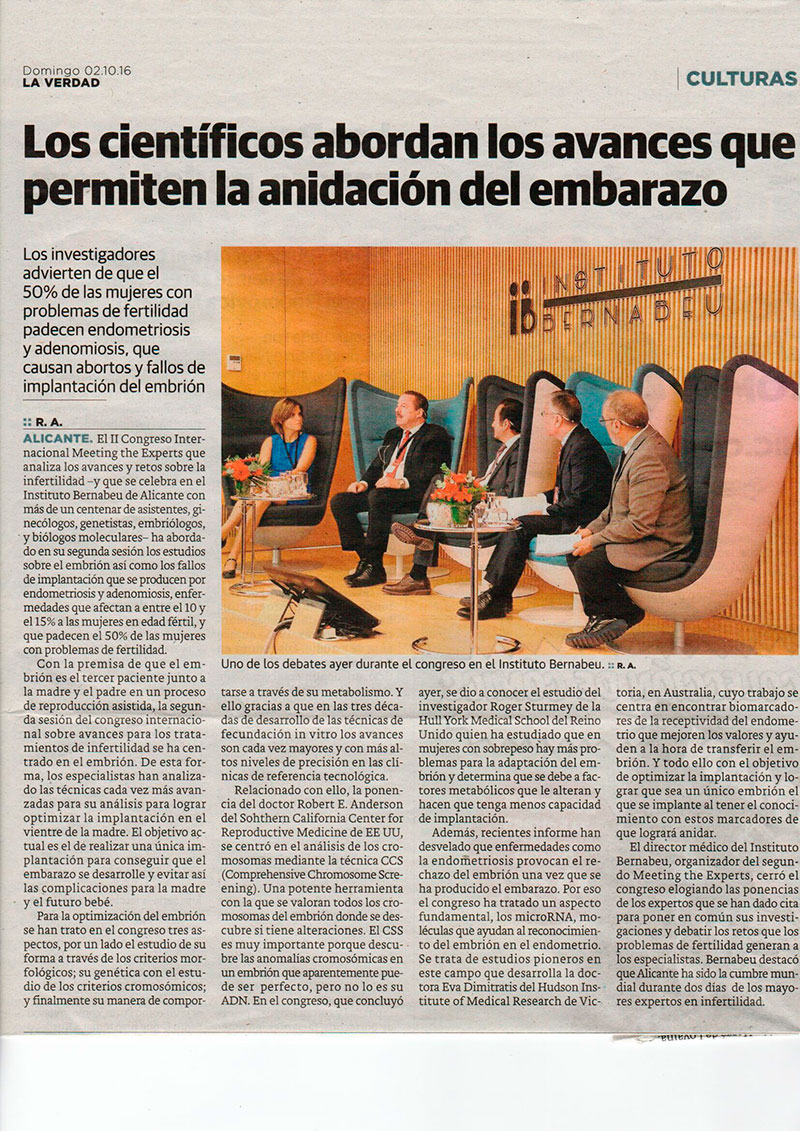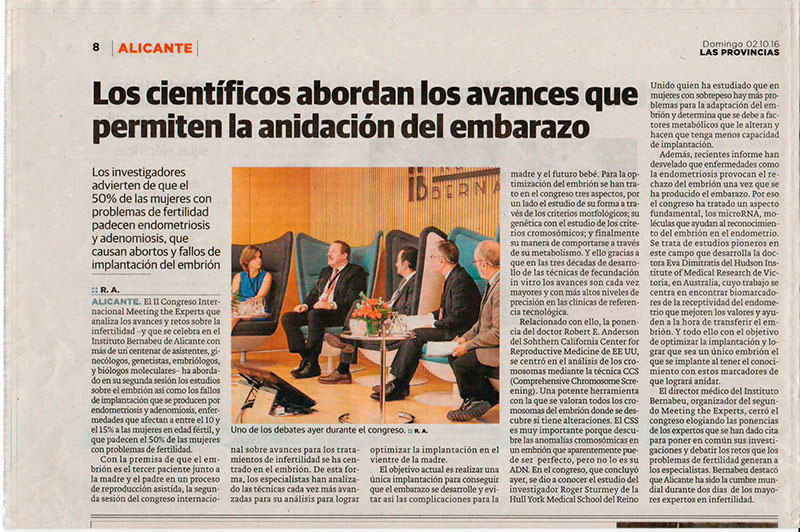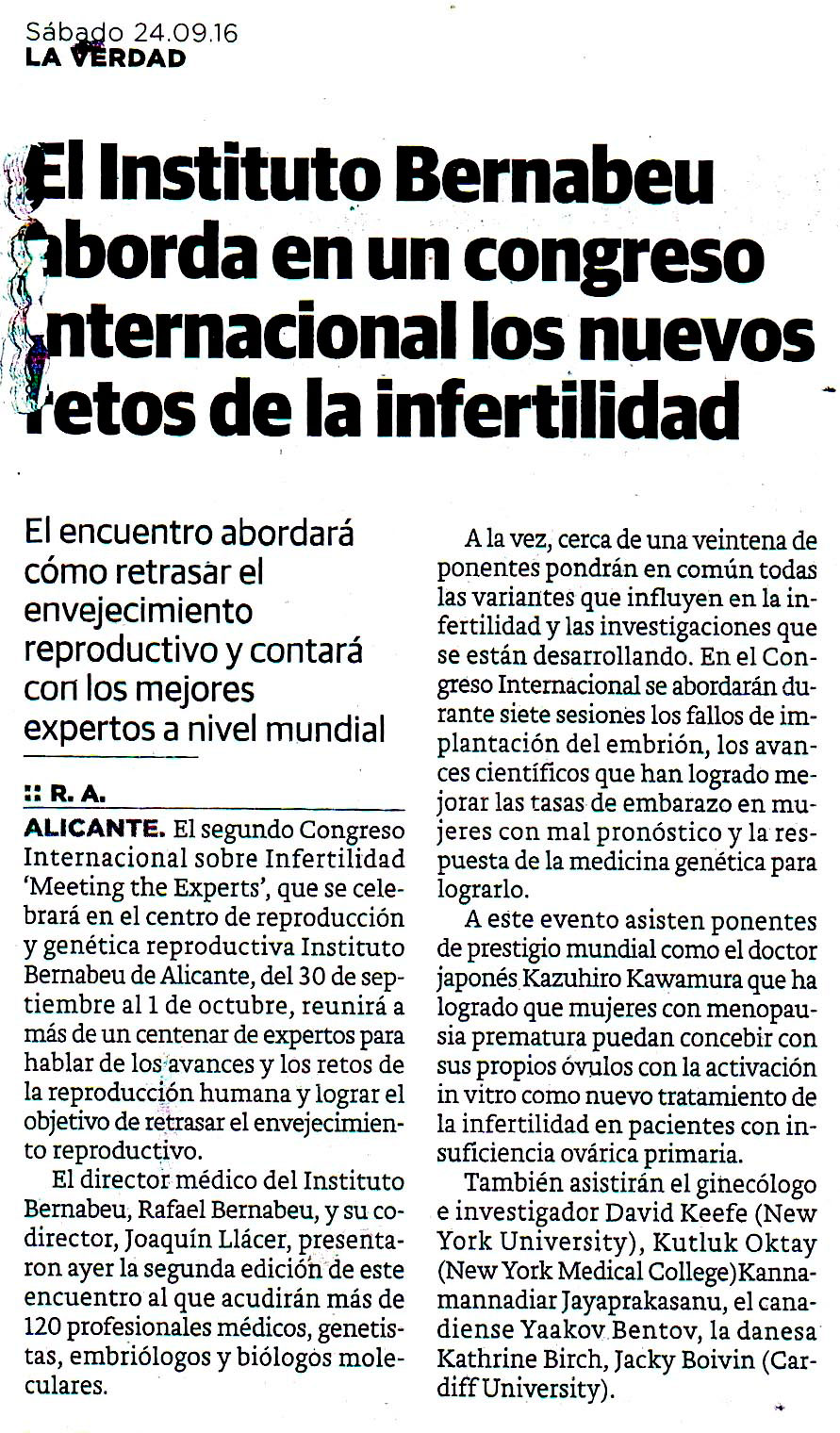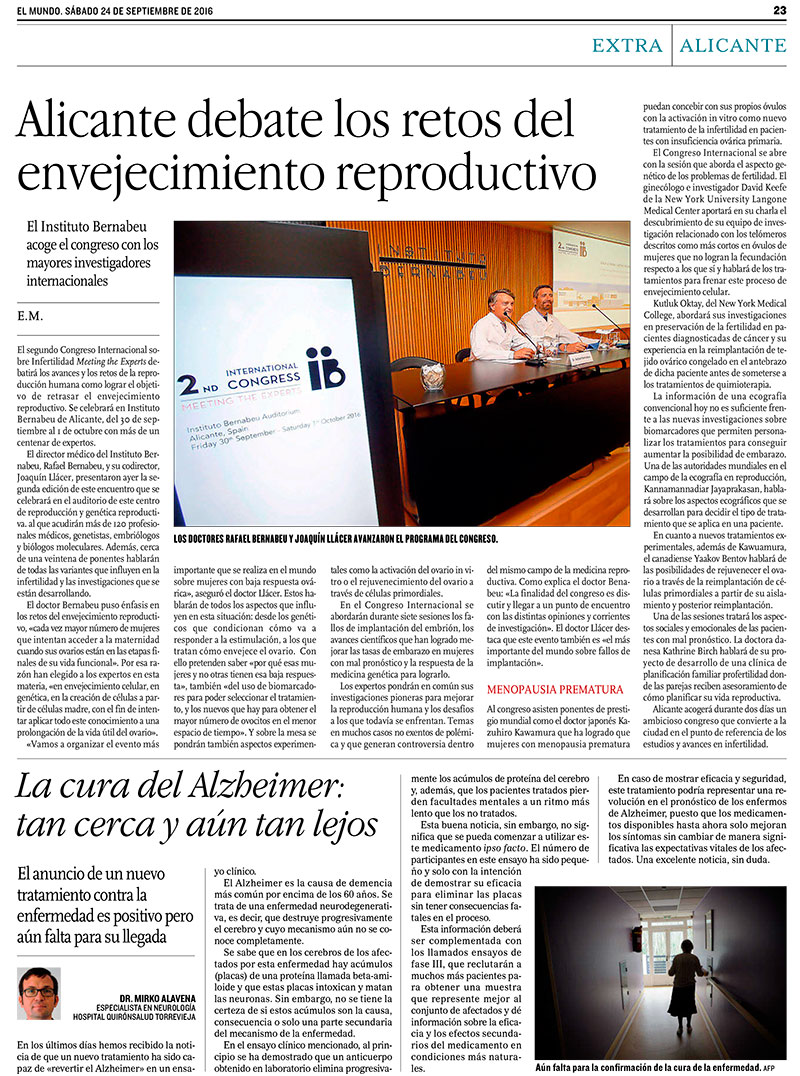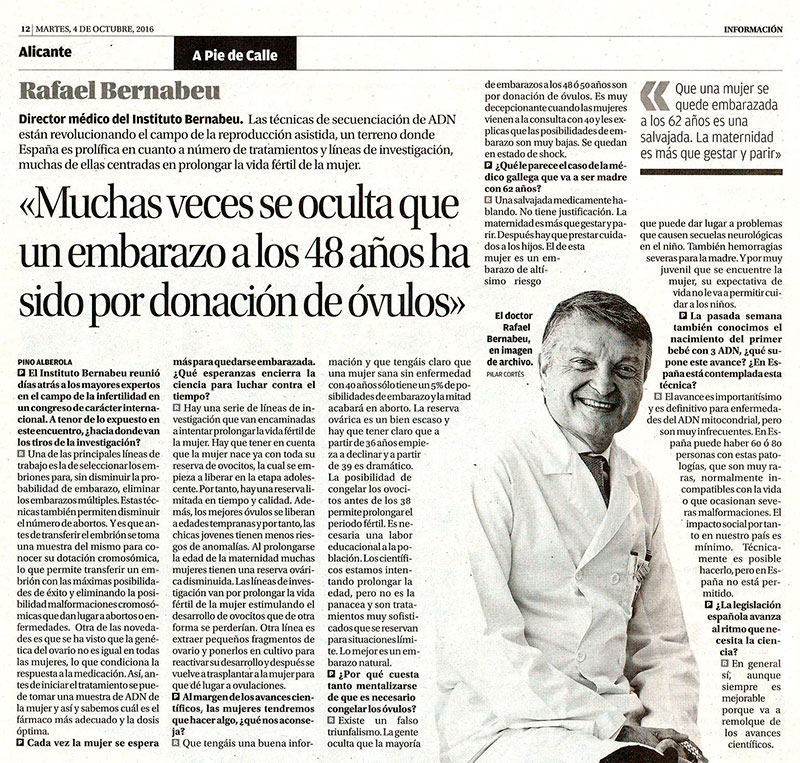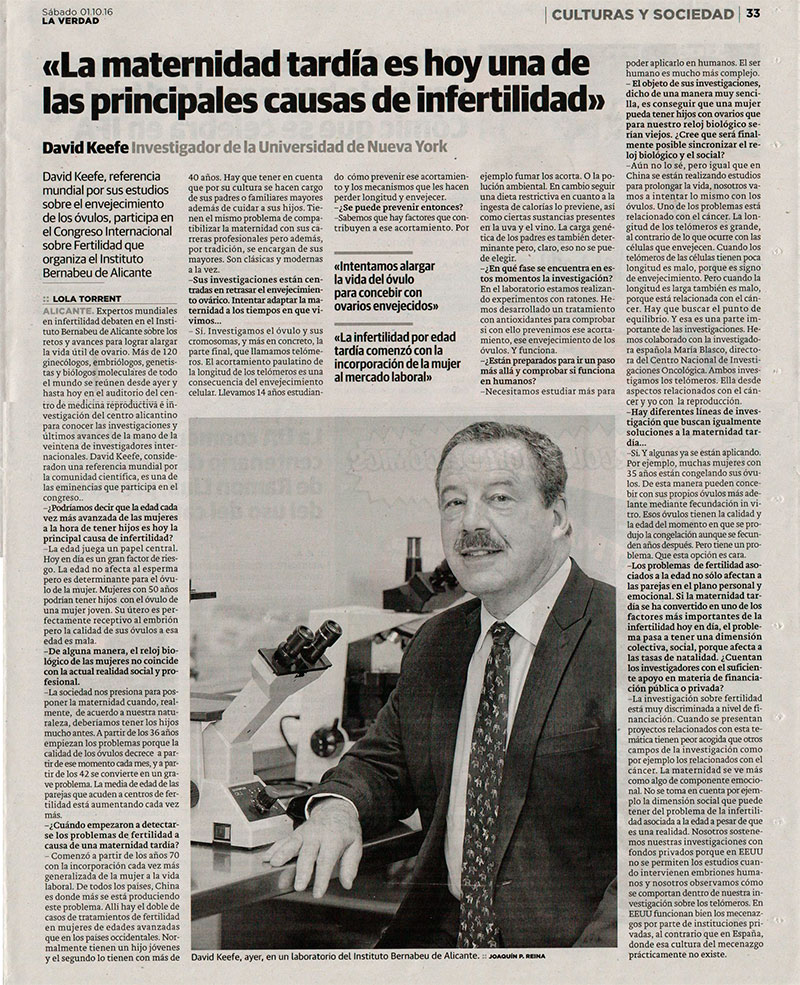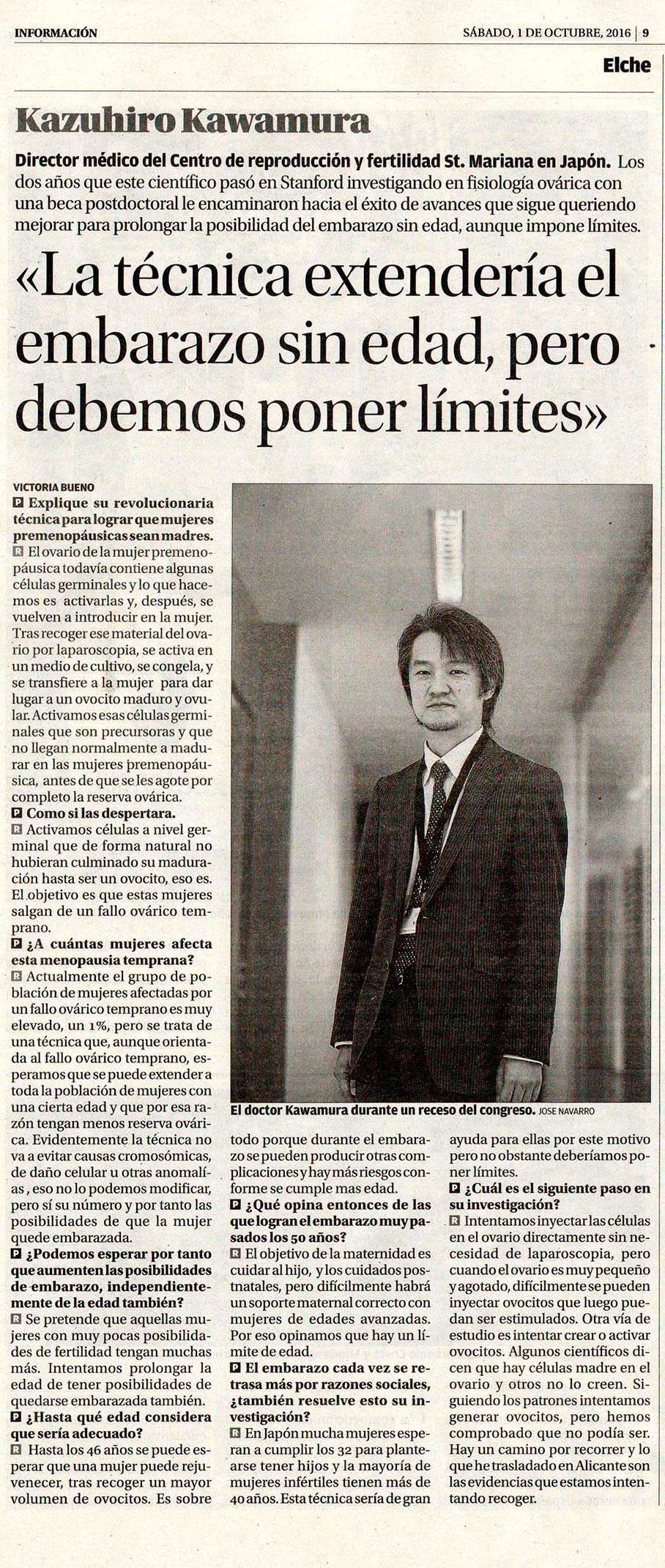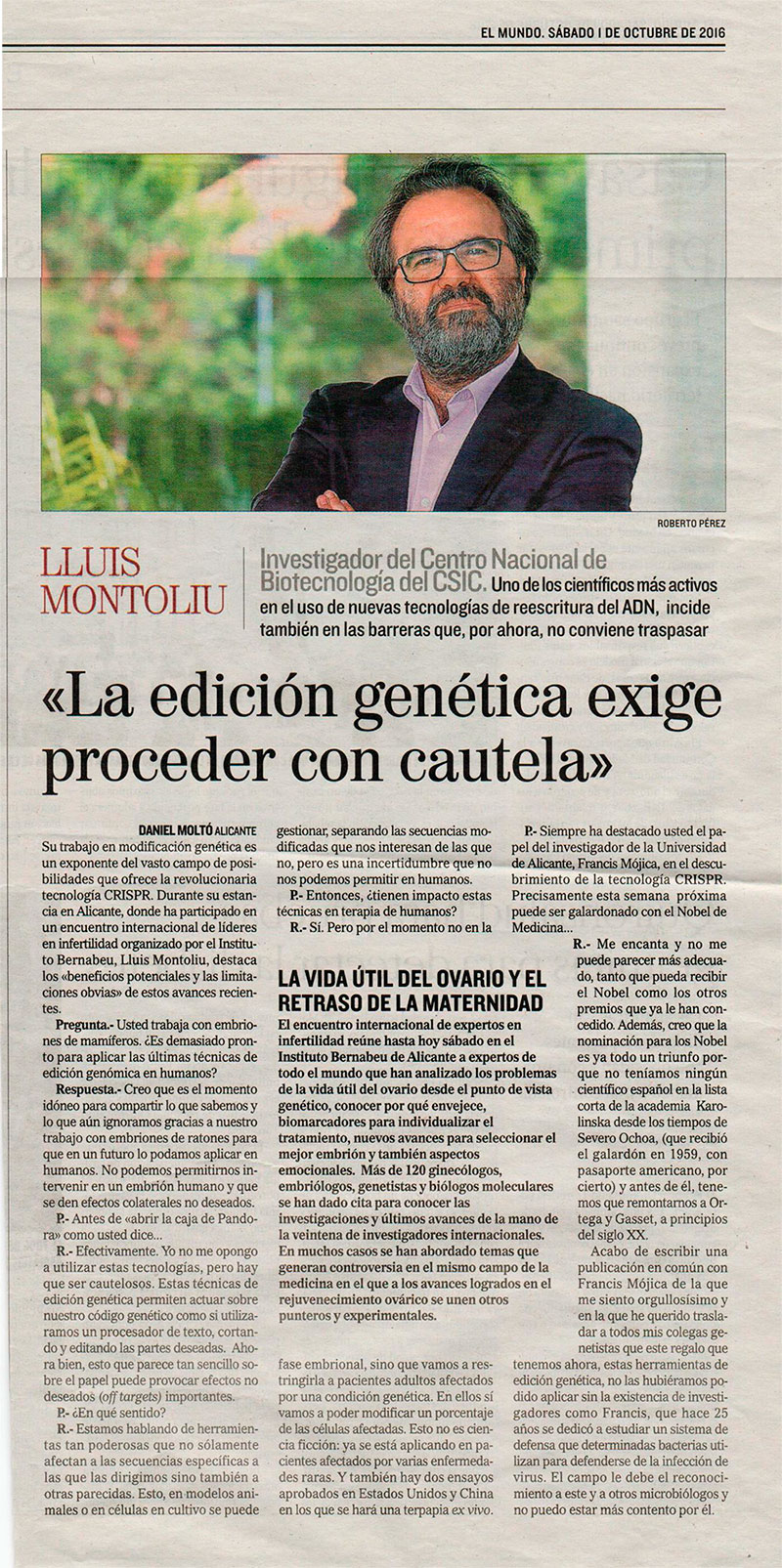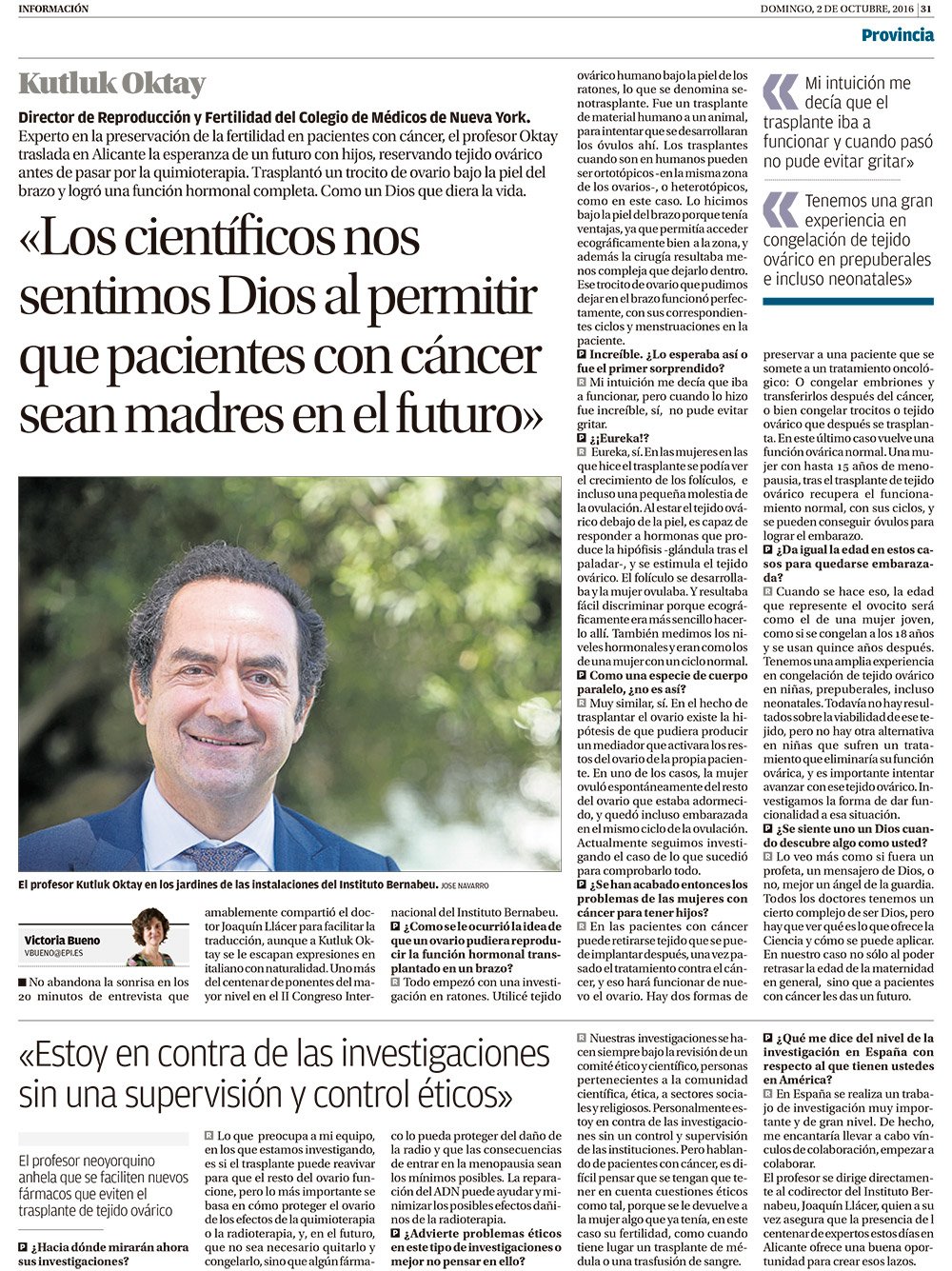World leaders in fertility gathered at the Instituto Bernabeu International Congress to present latest developments.
10-10-2016
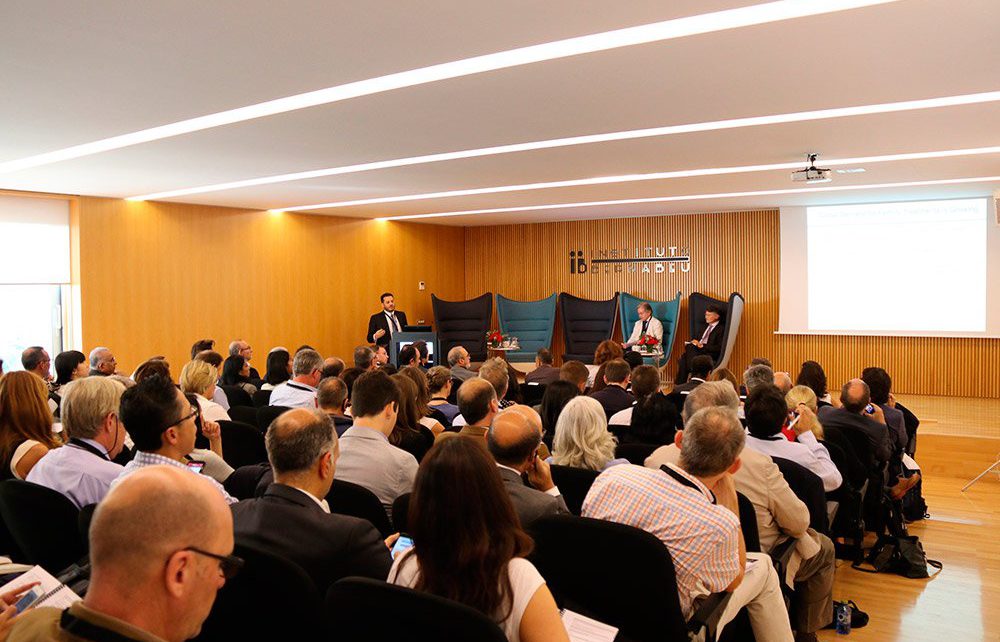
- In less than two decades, the average age at which couples have their first child has been pushed back from 26 to 31 years, coinciding with the onset of ovarian ageing and increased difficulties in getting pregnant.
- On the first day of the congress, experts from all over the world analysed the issues from a genetics point of view in order to understand why ovaries age, biomarkers for personalising treatment, progress in selecting the best embryo and also the associated emotional concerns.
- The second day covered recent progress in the embryo implantation process and various studies aimed at prolonging a woman’s fertility.
At the Instituto Bernabeu ‘Meeting the Experts’ Reproductive Medicine International Congress which was held on Friday 30th September and Saturday 1st October, worldwide leaders in fertility debated the challenges and the progress made in prolonging the ovary’s working life, as well as the latest research on poor ovarian reserve and embryo implantation. Over 120 gynaecologists, embryologists, geneticists and molecular biologists from around the world gathered in the Spanish reproductive medicine and research centre clinic’s auditorium in order to learn about research work and recent progress through presentations given by around twenty international researchers. In many cases, they are subject matters which generate controversy within the speciality itself, a speciality in which progress made in ovarian rejuvenation and in other cutting edge and experimental research coincide.
Rafael Bernabeu, Director of Instituto Bernabeu, summaries what he believes is today a social issue: «The placenta lasts for 9 months and the ovary for 40 years. If we take into account that the average lifetime of a woman is over 82 years, putting off maternity is nowadays a social issue», points out the organiser of the II Edition of the Meeting Experts Congress on fertility. «This leads us to think that there is an increasingly large number of women who try to become mothers at the most convenient time in their life but also at a time when their ovaries are coming towards the end of their functional lifetime. This is the reason why we have brought together experts on cell ageing, on genetics and on the generation of cells from stem cells with the aim of trying to apply all this understanding to prolonging the lifespan of the ovary», he adds.
In the 90s, the average age at which a woman had her first child was 26.8 years of age. It currently stands at 31.2 years. However, experts point out that the ideal biological age to become a mother is under 30 years of age.
Adds that the congress in Alicante «is currently the world’s most significant event on women with poor ovarian reserve. It involves leading experts who speak on all the aspects which play a role in women with poor ovarian response. The topics include the genetics which influence how she will respond to the stimulation provided by the medication, the genetics of how the ovary ages, why these women and not others have poor response, biomarkers for the selection of treatments and new treatment aimed at obtaining a greater number of eggs in the shortest time possible. It also looks at experimental aspects which are already becoming turning into a reality, such as in vitro activation of the ovary and ovarian rejuvenation using stem cells.
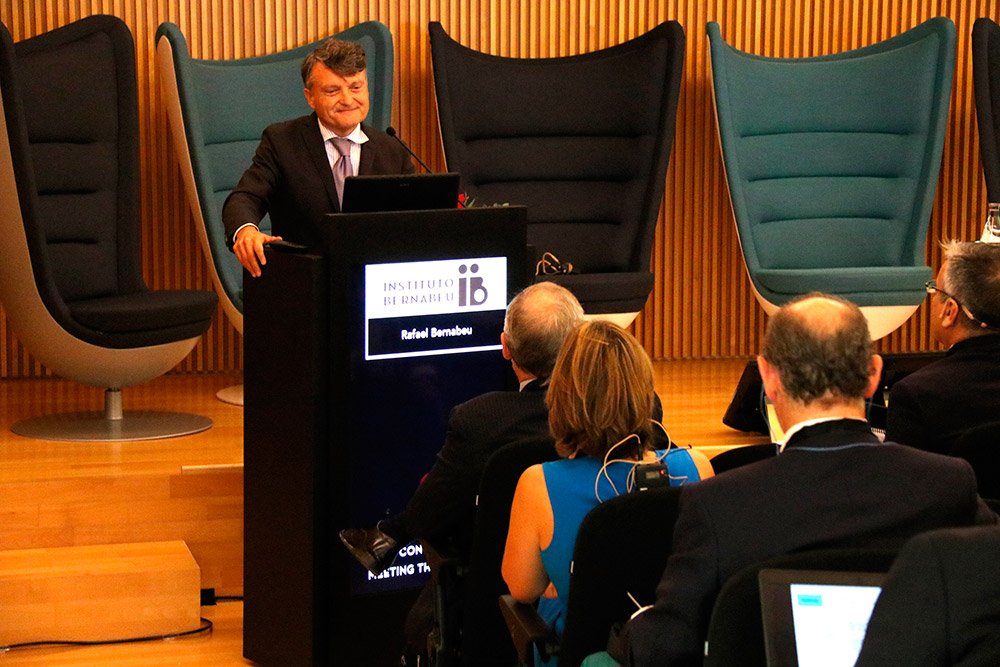
OVARY AGEING MECHANISMS
The first session at the international congress opened with the genetic aspects of fertility issues in which experts covered understanding the cell and genetics mechanisms which lead to ovary ageing, and the creation of the most appropriate stimulation protocol for the patient. That is, so-called pharmacogenetics which involves personalised treatment and the drugs which are best suited to the patient. This line of research is being led by Dr Belén Lledó from Instituto Bernabeu.
The factors which influence ovary ageing are the main concerns of American researcher, David Keefe. The scientist has proven that there is a link between a shortening in the length of telomeres and ageing in the ovary. In his speech, he explained that understanding the genes involved in the length of telomeres will help attempts to postpone the ageing of women’s ovaries.
The American doctor, Kutlik Oktay, is a worldwide leading authority on ovarian ageing research and fertility preservation. He spoke about a new technique, which is currently in experimentation stage, for treating couples who repeatedly produce poor quality embryos following in vitro fertilisation. The basis for this is the transfer of the patient’s own mitochondria from other cells to her eggs prior to fertilisation. Oktay pointed out that this could improve the prognosis in couples with these characteristics.
Another leading authority on understanding how the ovary works is the Japanese doctor, Kaxuhiro Kawamura, who led the team which achieved the birth of the first biological child in a woman suffering from premature menopause. The researcher presented his work in which, by activating ovarian tissue, mothers were able to mature eggs using in vitro treatment.
Regarding the options for rejuvenating the ovary, the Canadian doctor, Yaakov Bentov, explained his research work. It consists of re-implanting stem cells by isolating them and then later re-implanting them.
The sessions on Friday ended with a controversial issue led by Lluís Montoliu from the Spanish National Biotechnology Centre (CNB-CSIC). In his speech, he covered recent progress in mammal embryo genome editing using animal models and its possible use in human embryos. «The possible benefits linked to the obvious limitations and appropriate consideration of alternative methods which we already have under as valid strategies before opting for opening Pandora’s box», warned the researcher.
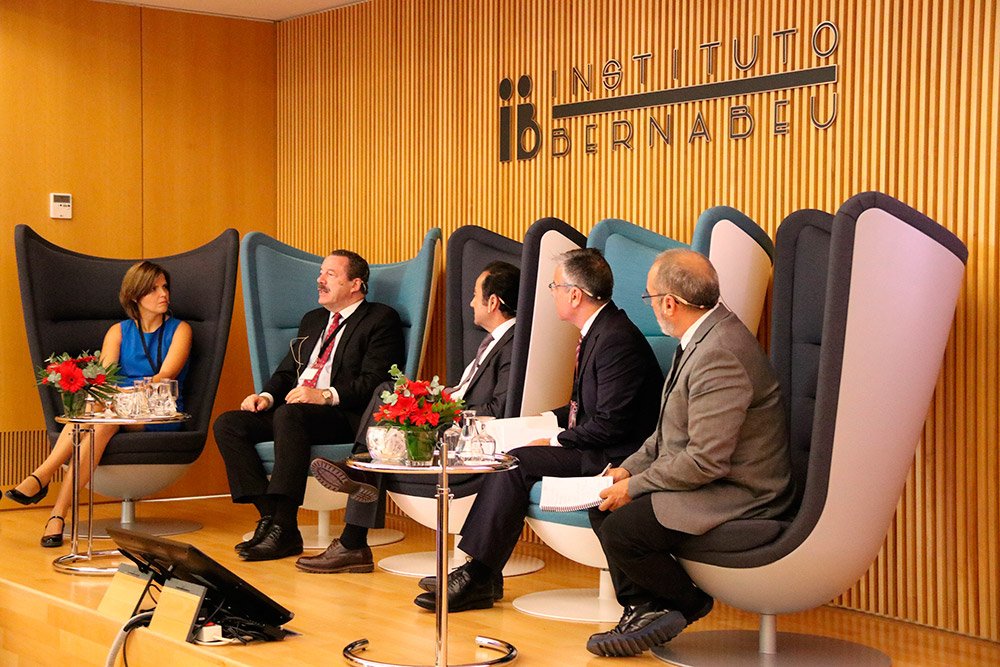
DAY TWO – A FOCUS ON EMBRYO IMPLANTATION
Based on the prerequisite that, along with the mother and the father, the embryo is the third patient in an assisted reproduction procedure, the second session of the international congress on progress in infertility treatment concentrated on the embryo. The specialists thus covered analysis of increasingly more advanced techniques for optimising implantation in the mother’s womb. The current aim is to carry out a single implantation procedure in order to achieve pregnancy, thus avoiding complications for the mother and the future baby.
In terms of optimising the embryo, the congress covered three aspects: studying embryo shape using morphological criteria; embryo genetics through studies of chromosomal criteria; and, last of all, embryo behaviour from the point of view of its metabolism. This is thanks to the fact that during the three decades of development in in vitro fertilisation techniques, progress is constantly increasing and there is improved precision in those clinics which are leading the way in technology.
With reference to the same issues, the presentation given by Dr Robert E. Anderson from the Southern California Center for Reproductive Medicine in the United States of America, covered chromosome analysis using CCS (Comprehensive Chromosome Screening) techniques. This is a powerful tool used to evaluate all the chromosomes in the embryo and with which any alterations can be detected. CCS is very important because it detects chromosomal abnormalities in an embryo which may appear to be perfect but which, in fact, in terms of DNA, is not.
The work of researcher Roger Sturmey from Hull York Medical School in the UK was shared. His research has shown that the embryo faces greater difficulties in terms of adapting in women who are overweight and he determines that this is due to metabolic factors which alter the embryo and make it less capable of implanting.
Additionally, recent research has revealed that illnesses such as endometriosis generate embryo rejection following pregnancy. It is for this reason that the congress dealt with an important aspect: mircoRNA molecules which help embryo recognition in the endometrium. These are pioneering studies in the field carried out by Dr Eva Dimitratis from the Hudson Institute of Medical Research in Victoria, Australia. Her work centres on finding endometrium receptivity biomarkers which improve values and help when transferring the embryo. This is all with the aim of optimising implantation and implanting a single embryo based on the knowledge with these markers, that it will do so successfully.
The Medical Director at Instituto Bernabeu and organiser of the second edition of Meeting the Experts brought the congress to a close. He praised the presentations given by the experts who gathered in Alicante with the aim of sharing their research and debating the challenges which fertility issues generate for specialists. Dr Bernabeu pointed out that, for two days, Alicante became the worldwide centre stage for leading experts in infertility.
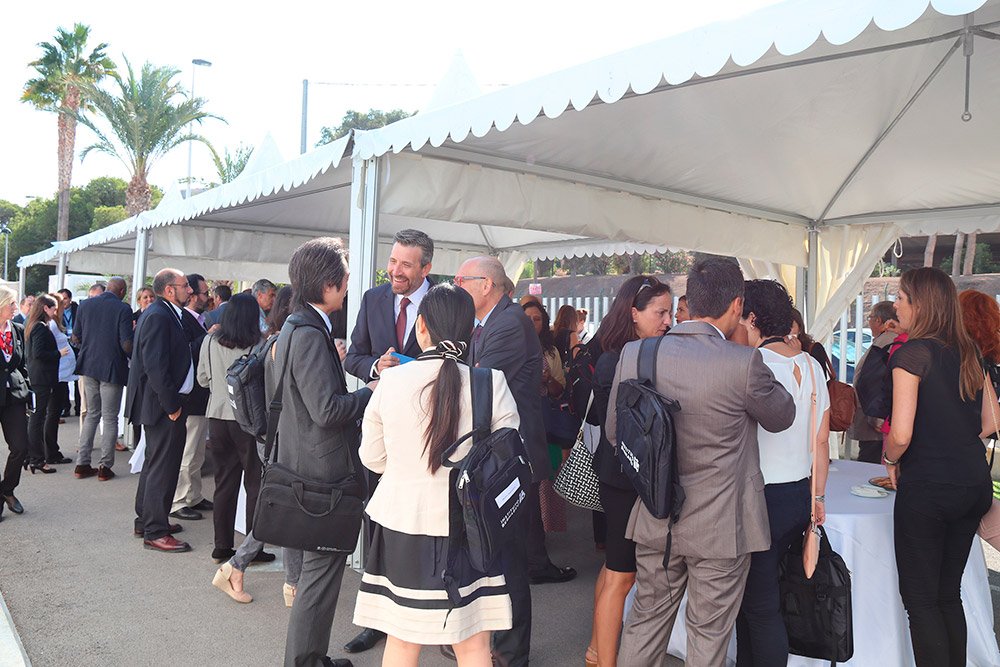
PRESS AND MEDIA:
Press gallery
25 SEPTEMBER
27 SEPTEMBR
28 SEPTEMBER
- Facebook Masquemedicos
- Twitter Masquemedicos
- Facebook Fertility Clinics Abroad
- WEB Health Tourims
- WEB Eizellspende
- BLOG Eizellspende
- Twitter Eizellspende
- Facebook Eizellspende
- WEB La Infertilidad
29 SEPTEMBER
- Facebook IVF Clinics World wide
- Twitter IVF Clinics World Wide
- WEB IVF Clinics World Wide
- Facebook La Infertilidad
- Twitter La Infertilidad
30 SEPTEMBER
- Diario Información
- Diario Información
- RTVE – Comunidad Valenciana
- La Verdad
- La Verdad
- Diario Información
- La Vanguardia
- Las Provincias
1 OCTOBER
- Diario Información
- Diario Información
- La Verdad
- El Mundo
- Deia
- Diario Información
- Diario Información
- Agencia EFE
- Eldia.es
- Deia
2 OCTOBER

